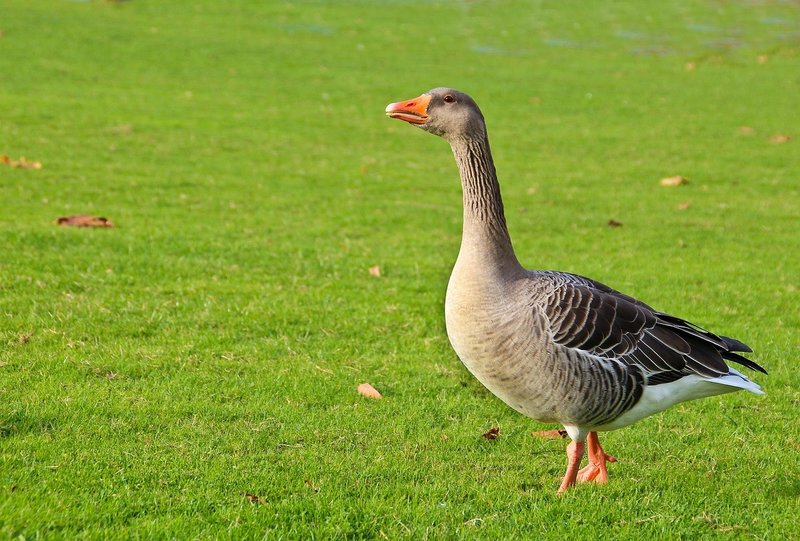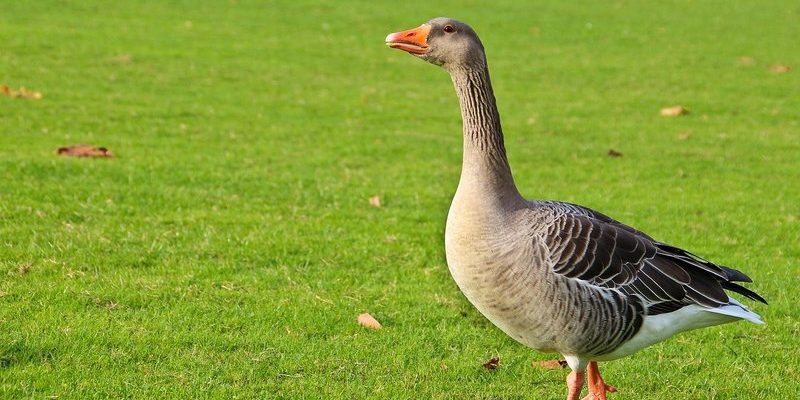
When we think of geese, we might picture them waddling around a park or honking loudly as they fly overhead. But there’s so much more to these fascinating birds than just their adorable antics! Geese are social creatures with a rich tapestry of behavior, unique characteristics, and a variety of species. They’ve been part of human culture for centuries, representing everything from companionship to food sources.
Like a feathered family unit, geese often travel together, migrate over long distances, and have strong bonds with one another. Their loud calls can be a sign of excitement or distress, making them quite expressive. So, let’s dive deeper into the world of geese and discover what makes them so special!
What is a Goose?
A goose is a type of waterfowl belonging to the family Anatidae, which also includes ducks and swans. They are characterized by their long necks, sturdy bodies, and webbed feet, making them excellent swimmers. There are many different species of geese, ranging from the familiar Canada goose to the elegant swan goose. Each species has its own unique traits and behaviors that set it apart from the rest.
Geese are primarily herbivores, feeding on grasses, grains, and aquatic plants. Their diet can vary based on their habitat and the season. You might even find them grazing in fields, nibbling on clover or corn. Their social nature means they often forage in groups, which can be quite a sight! Watching them interact can reveal a lot about their complex social structures.
Interestingly, geese are known for their migratory patterns. Many species travel thousands of miles between their breeding and wintering grounds. For example, the Canada goose migrates from North America to southern regions during the colder months. This migration is not only a fascinating natural phenomenon but also highlights their adaptability and resilience.
Physical Characteristics
Geese are recognizable by their distinct physical features. Many species have a robust body, a long neck, and a flat bill, which is perfect for grazing on grass and aquatic plants. Depending on the species, their size can vary significantly. For instance, the adult Canada goose can weigh between 5.5 to 14.5 pounds, while the larger Chinese goose can weigh up to 20 pounds!
Their plumage is generally a combination of gray, brown, black, and white, depending on the species. The classic Canada goose, for instance, has a black head and neck, white cheeks, and a brown body. This coloration helps them camouflage well in their natural habitats.
Another notable feature is their webbed feet, which enable them to paddle efficiently in water. This adaptation is crucial for their semi-aquatic lifestyle. In addition to swimming, geese are strong fliers, capable of reaching speeds of up to 50 miles per hour during migration!
Habitat and Distribution
Geese can be found in a variety of habitats, ranging from wetlands and lakes to agricultural fields and urban parks. Their adaptability means they can thrive in different environments, but they do prefer areas with water and abundant vegetation. You’ll often spot them in grassy meadows near lakes or rivers, especially during migration seasons.
In terms of distribution, geese are found on every continent except Antarctica. Some of the most common species include the Canada goose, Greylag goose, and the Barnacle goose. Each species has its preferred habitat, which can influence its migratory routes and breeding territories.
Geese are known for their strong social bonds and often form large flocks, especially during migrations. These flocks can be quite a sight, flying in V-shaped formations. This formation not only helps to conserve energy during long flights but also allows geese to communicate effectively as they navigate through the skies.
Behavior and Social Structure
One of the most intriguing aspects of geese is their social behavior. They are highly social birds that thrive in groups. Geese form strong family units, with parents often staying with their goslings for several months after they hatch. This familial bond is essential for teaching young geese survival skills.
The communication of geese is quite remarkable. They have a variety of calls, ranging from honks to whistles, which they use to convey different messages. For instance, a low honk might indicate contentment, while a series of rapid honks can signal alarm. This vocalization is key to their social interactions and helps maintain group cohesion.
Geese also exhibit fascinating behaviors like synchronized swimming and foraging. When feeding, they often work together to maximize efficiency. You might see them take turns grazing and keeping an eye out for predators. This teamwork not only supports individual survival but also strengthens their community bonds.
Reproduction and Lifespan
Geese typically mate for life, which is a testament to their strong social structures. During the breeding season, which usually occurs in spring, male geese engage in elaborate courtship displays to attract females. These displays can include vocalizations, head bobbing, and even synchronized swimming.
Nesting usually happens near water, with females building nests from grasses and reeds. After laying approximately 5 to 10 eggs, the female incubates them for about 28 to 30 days. Once the goslings hatch, they are precocial, meaning they can walk and swim shortly after birth. This early independence is crucial for their survival.
The average lifespan of a goose can vary with species and environmental factors but typically ranges from 10 to 25 years in the wild. In some cases, geese in protected environments or captivity can live even longer. Their ability to adapt to changing environments and social structures plays a significant role in their longevity.
Interesting Facts About Geese
| Size: | Varies by species, typically 2 to 20 lbs |
| Wingspan: | From 3.5 to 7 feet |
| Diet: | Herbivorous, primarily feeds on grasses and grains |
| Lifespan: | 10 to 25 years in the wild |
| Migration: | Many species migrate thousands of miles |
| Social Structure: | Highly social, often form strong family groups |
Conservation Status
Many goose species are currently stable, but some are facing significant threats due to habitat loss, hunting, and climate change. Organizations and conservation groups are working tirelessly to protect these birds and their habitats. For example, the Canada goose has become very common in North America, while other species, like the Emperor goose, are considered threatened.
Conservation efforts have proven successful in several areas. By creating protected wetland habitats and enforcing hunting regulations, we can help ensure that geese continue to thrive. Education also plays a vital role; by raising awareness about the importance of these birds, we encourage people to respect and protect them.
In addition to habitat preservation, initiatives like responsible hunting practices and promoting biodiversity are crucial for the continued survival of geese. Every small effort counts, and it’s essential to be mindful of our impact on wildlife.
FAQ
What do geese eat?
Geese primarily feed on a diet of grasses, grains, and aquatic plants. They are herbivorous, meaning they don’t eat meat. You’ll often see them grazing in fields or near water sources, munching on whatever they can find. In fact, they play an important role in their ecosystem by helping to control plant growth.
How do geese communicate?
Geese are quite vocal and use a variety of sounds to communicate. Their calls can indicate different things, like alarm or excitement. You might hear loud honks when they’re flying together in formation. Each honk has its own meaning, helping them stay connected as a group.
Do geese really mate for life?
Yes, many species of geese are known to mate for life! Once they find a partner, they typically stick together for breeding seasons and often continue their bond throughout their lives. This strong partnership helps them raise their goslings effectively.
How far do geese migrate?
The migration distance for geese can vary greatly depending on the species. For example, the Canada goose migrates between Canada and the continental United States, covering thousands of miles. Some geese may travel over 2,000 miles to find suitable breeding or wintering grounds!
What is the lifespan of a goose?
The lifespan of a goose can vary depending on the species and environmental conditions. Generally, geese can live anywhere from 10 to 25 years in the wild. Some individuals in captivity have even been known to live longer, thanks to protection from predators and a steady food supply.
Are geese aggressive?
While geese can be protective, especially when nesting, they are generally not aggressive unless they feel threatened. If you approach a goose’s nest or goslings, it might honk loudly or try to chase you away. It’s important to give them space and respect their territory.
Can geese swim?
Absolutely! Geese are excellent swimmers thanks to their webbed feet. They use these feet to paddle efficiently in water, making it easy for them to forage for food. Their buoyant bodies help them move gracefully in aquatic environments!
What sound do geese make?
Geese are known for their distinctive honking. However, they produce a range of sounds, including soft whistling and clucking noises. Each sound serves a different purpose, whether it’s communicating with their mate, alerting the flock of danger, or simply expressing contentment.
Are all geese migratory?
Not all goose species are migratory. While many do migrate, some, like the resident Canada goose, may not travel far from their nesting areas if resources are abundant. Migration habits can depend on factors such as food availability and climate conditions.
How can I help protect geese?
You can help protect geese by advocating for wetland conservation and habitat protection. Being mindful of your impact on the environment, practicing responsible outdoor activities, and supporting wildlife organizations can all contribute to the survival of geese and their habitats.
Can you keep geese as pets?
Yes, many people keep geese as pets! They can be friendly and social animals, forming strong bonds with their human caretakers. However, they require sufficient space, a clean water source, and proper care. Be prepared for their vocal nature and need for companionship!
What role do geese play in the ecosystem?
Geese play an important role in their ecosystems. They help maintain plant growth by grazing, which can benefit other species in their habitats. Additionally, by dispersing seeds through their droppings, they contribute to the growth of new plants, helping to sustain the environment around them.

